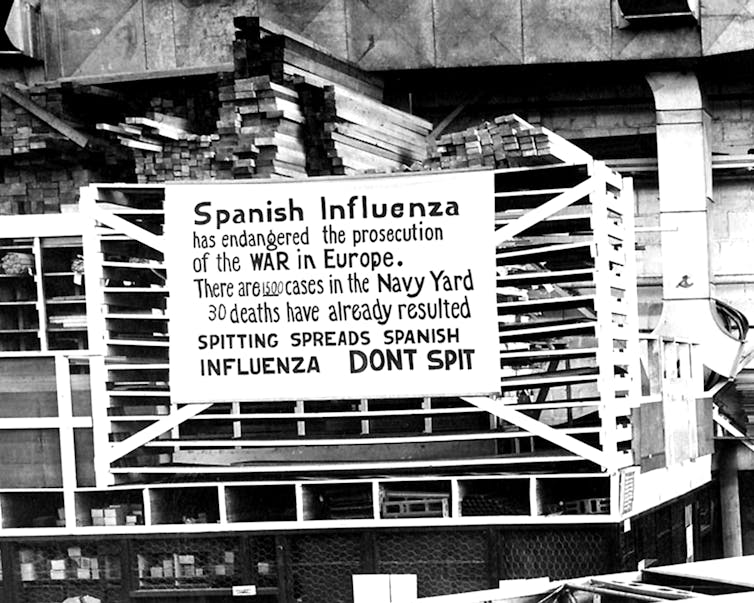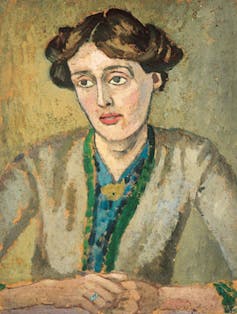Virginia Woolf: writing death and illness into the national story of post-first world war Britain.
Another interesting piece from The Conversation, by Jess Cotton, Lecturer at the School of English, Communication and Philosophy, Cardiff University.
Illness, unlike war, as English academic and writer Elizabeth Outka brilliantly demonstrates in her book Viral Modernism(2019), is a story that easily slips out of cultural and historical memory.
In illness, the modernist writer Virginia Woolf observed, “We cease to be soldiers in the army of the upright; we become deserters.” Woolf, writing in the wake of the first world war, saw the threat that the Spanish flu of 1919 posed to the stories of national triumph. Influenza moves in invisible and unpredictable ways. It renders everyone potentially vulnerable.
This interest in illness was personal. Woolf came down with several bouts of influenza between 1916 and 1925 and needed to confine herself to bed for stretches of time.
She documents the experience of the Spanish flu in her diary in 1918, noting, as an aside, how “we are, by the way, in the midst of a plague unmatched since The Black Death, according to the Times, who seem to tremble lest it may seize upon Lord Northcliffe and thus precipitate us into peace.”
Her tone is mocking. She would later appreciate the seriousness the threat of influenza posed. But here she suggests that what illness promises to bring is the end of the profit of war that fuels the nationalist sentiments churned out by the newspapers owned by Lord Northcliffe’s vast empire of popular journalism.
Reading Woolf’s work, particularly her 1925 novel Mrs Dalloway, on the 80th anniversary of her death and in the midst of our own pandemic, we see how she tried to rewrite death and illness back into the national story of post-first world war glory and strength.
Sidelining death
I’m a lecturer in English at Cardiff University, and teaching literature in a sparsely filled lecture theatre during the pandemic has been a discombobulating experience. Mrs Dalloway provided an entry point to make sense of the business of studying and thinking while a new national emergency unfolded around us. The protagonist of Mrs Dalloway is a survivor of the Spanish flu of 1919 and the sense of life that permeates the text emerges from her experience of rediscovering the pleasures of life. We meet Mrs Dalloway as she weaves her way through London, experiencing the quiet intensity of life one morning in June.
The novel’s famous opening line – “Mrs Dalloway said she would buy the flowers herself” – has taken on new resonance this year as the pandemic has made all our worlds much smaller. Clarissa wants to buy the flowers herself because she is delighted to go out – as we might appreciate – having spent so long indoors.
In class, the students and I thought about what it meant to see Clarissa as a character who has lived through a pandemic and who has come out the other side. Clarissa’s commitment to life, after a long confinement, is hopeful, though my students weren’t all convinced that it felt like one.

At the centre of Clarissa’s party, which the novel builds to, comes the news that Septimus Smith, a young war veteran, has killed himself. In Woolf’s original plans for her novel, Septimus did not appear and Clarissa was to kill herself during the party. In creating Septimus as Clarissa’s double, Woolf is able to move death to the sidelines – as we all would like to.
Woolf revolutionises character by radically tunnelling inwards – giving us not a description of a character, but a map of their psychic life. We experience the protagonist intimately from within – through their stream of consciousness – but peripheral characters also proliferate in the modernist novel.
Woolf recognises how easily it is to cast characters to the sidelines of life. This is, after all, how national fictions work, by making space for protagonists at the expense of those who are pushed further out of view. In the case of post-war Britain, space was made for the glory of war but not for the the Spanish flu.
Collective memory

Mrs Dalloway is a text that shows how memory and mourning work to uphold the values of the British Empire. Its attention on how emotions circulate between people allows us to understand how national structures of feeling are created through newspapers and through the orchestration of symbolic identifications.
“In all the hat shops and tailors’ shops strangers looked at each other,” Woolf writes, “and thought of the dead; of the flag of Empire.” Woolf is interested in showing something that is hard to pinpoint: how national communities are created and sustained; how the war’s dead continue to underpin an inexorable sense of Britishness.
Woolf saw that a subjective perspective was required to make sense of how death continues to inflect the mood of a generation. Mourning, as Sigmund Freud also realised at a similar point, is ongoing, illusory work. What is remarkable about her writing is that Woolf draws our attention to how death pushes us beyond what we can know. In this unknowing, we are forced to admit that our lives are more fragile and dependent on the lives of others.
As one of her characters articulates in The Voyage Out (1915):
“It seems so inexplicable,” Evelyn continued. “Death, I mean. Why should she be dead, and not you or I? It was only a fortnight ago that she was here with the rest of us?”
Woolf’s ability to show how hard it is to explain death helps us understand the difficulty of living with its presence. In the face of the loneliness of death, the growing demise of its communal forms, the diminished structures of public mourning, she provides us with a language for death outside of national structures of commemoration.
In : Writers
Tags: virgina woolf
blog comments powered by Disqus
 Hello. I'm Nick Hennegan and I started the London Literary Pub Crawl. Most of the blogs on here will be by me. I've always written but my first theatrical success was an adaptation of Shakespeare's 'Henry V' (www.HenryVPlay.com) I founded Maverick Theatre in 1994. (www.MaverickTheatreCompany.com) This pub crawl is really more a promenade theatre performance than a tour and I'm running it with a bunch of enthusiastic local actors and writers. I love sharing my passion for the area and the artists. I also present a weekly radio show, 'Literary London' on Resonance 104.4fm - London's Arts Station and a podcast on our site.
If you haven't visited us in London yet, I hope you'll come soon. Have a look at my new site, www.BohemianBritain.com. And feel free to leave comments or email me at nick @ LondonLiteraryPubCrawl.com - I reply to them all and I love to hear from you.
Hello. I'm Nick Hennegan and I started the London Literary Pub Crawl. Most of the blogs on here will be by me. I've always written but my first theatrical success was an adaptation of Shakespeare's 'Henry V' (www.HenryVPlay.com) I founded Maverick Theatre in 1994. (www.MaverickTheatreCompany.com) This pub crawl is really more a promenade theatre performance than a tour and I'm running it with a bunch of enthusiastic local actors and writers. I love sharing my passion for the area and the artists. I also present a weekly radio show, 'Literary London' on Resonance 104.4fm - London's Arts Station and a podcast on our site.
If you haven't visited us in London yet, I hope you'll come soon. Have a look at my new site, www.BohemianBritain.com. And feel free to leave comments or email me at nick @ LondonLiteraryPubCrawl.com - I reply to them all and I love to hear from you.